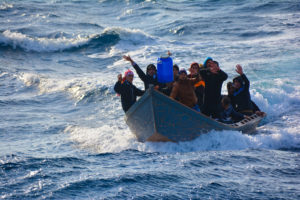In 2016, among the 20,000 unaccompanied migrant children who arrived in Italy, 6000 disappeared off the radar of the Italian authorities. (Repubblica, 2016) These minors are mainly of Eritrean, Somalian and Egyptian origin, aged 10-16 years old. Unfortunately, Italy has not found an effective solution to this serious problem.
A difficult arrival in Italy for minors
Minors arriving in  Italy find themselves facing many obstacles – far from the situation they expected. First of all, they find themselves in often unsanitary and overcrowded reception centres (Rodini, 2017). Their uncertain status and the irregularity of their situation in the country also means that they can neither study, nor work to repay the people who paid for their journey across the Mediterranean. On top of all that, the procedures for family reunification are extremely long and complex. It is for these reasons that a very large number of minors (6000 under 16 years old in 2016) decide to flee the centres and become undocumented migrants (Save the Children, 2017).
Italy find themselves facing many obstacles – far from the situation they expected. First of all, they find themselves in often unsanitary and overcrowded reception centres (Rodini, 2017). Their uncertain status and the irregularity of their situation in the country also means that they can neither study, nor work to repay the people who paid for their journey across the Mediterranean. On top of all that, the procedures for family reunification are extremely long and complex. It is for these reasons that a very large number of minors (6000 under 16 years old in 2016) decide to flee the centres and become undocumented migrants (Save the Children, 2017).
They live on the street, possibly with adults of the same nationality, and are helped – if they are lucky – by volunteers from associations working in the field. Most of them will try to find the money to leave Italy and re-join family members in another European country or simply try to apply for asylum in another country.
The extreme vulnerability of unaccompanied minors
It should be remembered  that all of these minors are already vulnerable due to psychological or health problems, or learning difficulties. However, all are equally at the mercy of human traffickers, who can easily manipulate them. (Repubblica, 2016) This has resulted in widespread, illegal exploitation, with most cases involving sexual abuse of minors.
that all of these minors are already vulnerable due to psychological or health problems, or learning difficulties. However, all are equally at the mercy of human traffickers, who can easily manipulate them. (Repubblica, 2016) This has resulted in widespread, illegal exploitation, with most cases involving sexual abuse of minors.
Ultimately, the fate of minors, their survival and their journey across Europe is a question of money. In the best of cases, it is the parents or family who send the money needed for them to continue their journey through Italy and beyond its borders. In other cases, these minors try to earn money through undeclared work, petty crime, drug trafficking or prostitution (Repubblica, 2016).
The inadequacy of the Italian legislative system
The main cause of this desperate situation is the absence of a specific law for the protection of migrant minors. Currently, the following standards are in force in Italy: the 1989 New York Convention on the Rights of the Child, according to which unaccompanied minors have the right to a residence permit, and the Legislative Decree 268/1998 on immigration, which provides general regulations on the issue.  These measures are insufficient to address this problem (Camilli, 2017), since neither of the two provides any solutions for migrant minors who leave reception centres.
These measures are insufficient to address this problem (Camilli, 2017), since neither of the two provides any solutions for migrant minors who leave reception centres.
The Zampa bill, which introduces a specific regulation for the protection of migrant minors,is supposed to remedy these problems. However, this bill has been awaiting the approval of the Italian Parliament since 2013 – nearly 4 years! In summary, the bill covers five areas:
1. A uniform procedure at the national level for the age verification and identification of minors
2. A structured system of reception in Italy with organised structures
3. Respect for the best interests of the minor
4. The right to education and health
5. Minors’ right to legal aid and to be heard in any judicial and administrative procedures they are involved in (Save the Children, 2017).
How much longer will it take to pass this bill?
NGOs turn to national and international authorities
Tired of this deplorable situation, Oxfam is asking the Italian and European authorities to intervene rapidly, in order to guarantee these minors the suitable accommodation and sufficient support they need for a decent life (Oxfam Italy, n.d.) – a position that is also supported by Save the Children (2017). We hope their appeal is heard.
Written by : Francesca Corsetti Translated by :Amanda Fearnley Proofread by : Ann Green |
Camilli, A. (2017, 02 13). Internazionale. Accessed on 03/03/2017, at internazionale.it: http://www.internazionale.it/notizie/annalisa-camilli/2017/02/13/migranti-minori-non-accompagnati-legge-zampa
Oxfam Italia. (n.d). Accessed on 02/11/2017, at oxfamitalia.org: https://www.oxfamitalia.org/ogni-giorno-28-bambini-scompaiono-dal-sistema-di-accoglienza-italiano/
Repubblica. (2016, 10 26). Accessed on 02/10/2017, at Repubblica.it: http://www.repubblica.it/esteri/2016/10/26/news/migranti_minori_inchiesta_lena_repubblica_el_pais_welt_le_soir_die_welt-150581936//
Rodini, G. (2017, 01 4). Accessed on 03/03/2017, at ilfattoquotidiano.it: http://www.ilfattoquotidiano.it/2017/01/04/centri-daccoglienza-il-racconto-in-italia-condizioni-disastrose-la-struttura-di-cona-una-delle-peggiori/3294706/
Save the children. (2017, 02 10). Accessed on 02/10/2017, at savethechildren.it: https://www.savethechildren.it/blog-notizie/minori-migranti-cosa-si-inten

